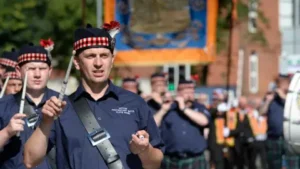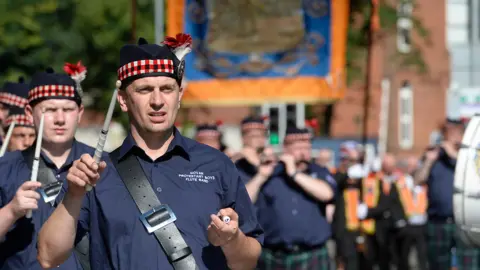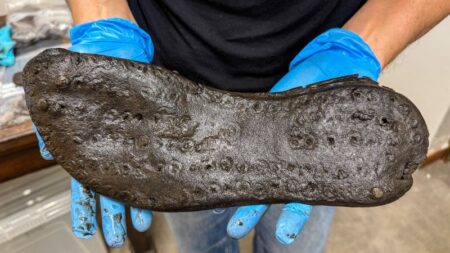The Twelfth of July is an annual event in Northern Ireland that draws thousands of participants and spectators, commemorating the anniversary of the Battle of the Boyne, which took place in 1690. This celebration is pivotal to the Orange Order, a fraternal organization that promotes Protestant identity and Ulster-Scots heritage. This year the parades were marked by large crowds in cities, towns, and villages throughout Northern Ireland, with locals and visitors coming together to partake in the festivities.
Members of the Orange Order, along with marching bands and community supporters, marched in various locations including Belfast, Coleraine, Dromara, and Keady. The event holds significant cultural importance for Unionist communities, emphasizing a collective identity tied to historical events and traditions. Notably, lodges from Scotland were among the participants, showcasing the broader ties many feel to the cause being celebrated. This year’s main parade in Belfast commenced from the Orange Hall located on Clifton Street in North Belfast, a symbolic venue for such celebrations.
In Keady, County Armagh, Northern Ireland Office Minister Fleur Anderson and Deputy First Minister Emma Little-Pengelly were seen attending celebrations, embracing the spirit of community that the Twelfth embodies. Reverend Mervyn Gibson, the grand secretary of the Orange Order, categorized the days leading up to the Twelfth as “tremendous,” highlighting the peaceful nature of the celebrations and the happiness that stemmed from the successful organization of the event.
The streets were filled with not only participants but also enthusiastic onlookers, many of whom traveled from different regions, including England. Some of these spectators, like Lyndsay and Melissa from Birmingham, shared their delight at experiencing the event for the first time. They expressed that the passionate display of cultural identity was truly beautiful, hinting at how such traditions are passed down through generations and remain relevant in today’s society.
Despite the warmth of the weather, which saw many participants dressed in full regalia—including suits and traditional attire—there was a general sense of camaraderie and relaxation among both participants and spectators alike. The event offered ample opportunities for families to bond over shared experiences and the joyous activity of the day. While some felt the heat of the sun was a challenge, many were grateful that the rain stayed away, enabling them to enjoy the parades fully.
Tradition also extended to the Eleventh night prior to the Twelfth, which is marked by the lighting of bonfires—a custom that dates back to the time of King William III to welcome his arrival at the battle site. Although most bonfires were lit without incident, some raised concerns due to their size, location, or potential hazards. This year, a controversial bonfire in south Belfast raised alarms due to the presence of asbestos and its proximity to an electricity substation, demonstrating the challenges that come with traditional celebrations in modern contexts.
As part of the celebrations, various leaders within the political landscape, such as Gavin Robinson, the leader of the Democratic Unionist Party, endorsed themes of unity within the unionist community, calling for greater cooperation amongst different factions during his speech at the conclusion of the Belfast parade. His emphasis on faith and freedom resonated well with the attendees, further solidifying the day’s intent as not merely a commemoration but an affirmation of identity and community spirit.
Overall, the Twelfth of July serves not only as a historical commemoration but also as an active celebration of contemporary cultural identities within Northern Ireland. As the parades concluded, sentiment among participants and spectators alike was one of joy and communal participation, affirming the day’s significance for all involved in these colorful and lively festivities.











